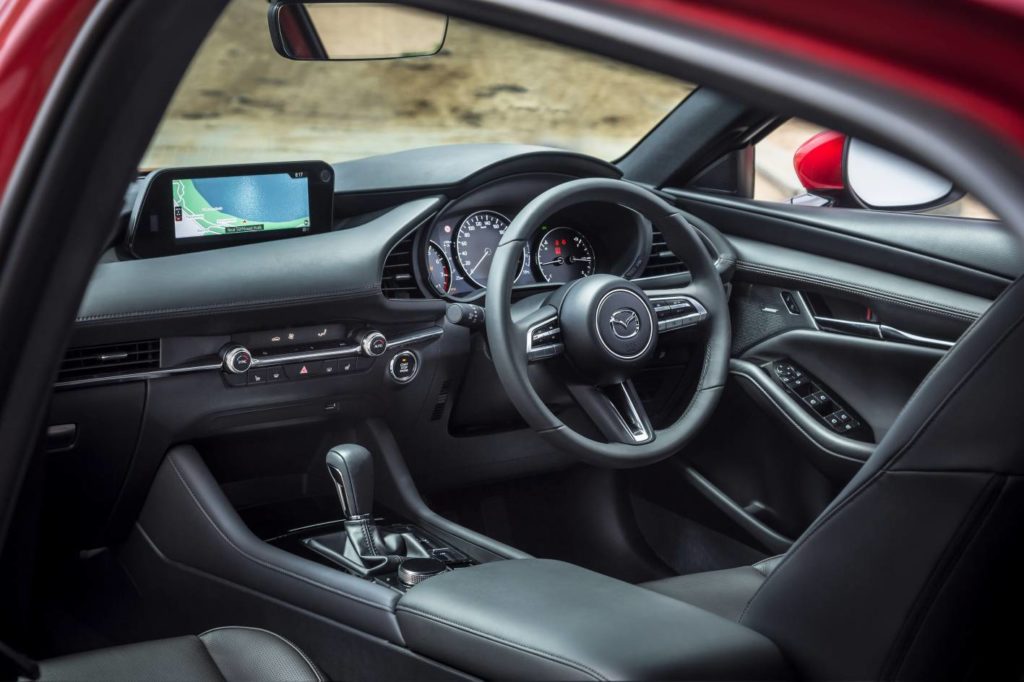Having faced stiff competition from the likes of the Hyundai i30, Toyota Corolla, Kia Cerato and Ford Focus in recent years, the next-gen Mazda 3 has been reoriented for a more premium position in the market.
Having faced stiff competition from the likes of the Hyundai i30, Toyota Corolla, Kia Cerato and Ford Focus in recent years, the next-gen Mazda 3 has been reoriented for a more premium position in the market.
Reflecting customers’ moves away from the entry level model, this new offering brings luxury and safety to the forefront with a chic new exterior design and top of the line safety tech.
Now included as standard are a button start, seven airbags and upgraded tech like radar-guided active cruise control, blind-spot monitoring, rear cross-traffic alert, lane departure warning and front and rear autonomous emergency braking.
A new outward look
Thanks to a sleek new headlight and grille design and a C-pillar fitted at the rear, the bold new exterior has elicited a love or hate reaction. Slightly lower and shorter than the previous model, it still fits well into the ‘small car’ category, but with a sophisticated look you’d expect for a premium buyer.
All 5 options come in a range of standard colours, including ‘Snowflake White Pearl’, ‘Sonic Silver’, ‘Machine Grey’, Jet Black’, ‘Titanium Flash’ and ‘Deep Crystal Blue’. Metallics are available at an additional $495, with a choice of ‘Machine Grey metallic’, ‘Polymetal Grey metallic’ and the always popular ‘Soul Red Crystal metallic’.
18-inch alloy wheels are standard, and a subtle body kit’s also on offer with side skirts, a rear diffuser and front spoiler. A rooftop spoiler is standard on the hatch, with twin chrome exhaust standard on both hatch and sedan.
A chic interior view
Reflecting their new market position, all models now come with a head-up display, 8.8-inch screen, reversing camera, sat nav, Apple CarPlay and Android Auto, along with digital radio, Bluetooth and steering wheel mounted controls.
Reflecting their new market position, all models now come with a head-up display, 8.8-inch screen, reversing camera, sat nav, Apple CarPlay and Android Auto, along with digital radio, Bluetooth and steering wheel mounted controls.
The G24 GT and G25 Astina now also boast a 12-speaker Bose stereo, but the standard eight-speaker system on the remaining grades is certainly nothing to sneeze at.
Minimalist design is the order of the day in the interior, with high quality feel materials, a dark colour scheme and subtle climate and media control labelling. Cupholders have been moved and are now in front of the shifter, ushering in a longer centre armrest and a bigger console. The centre screen is also now slightly further away, allowing for a more streamlined ‘cockpit’ like feel.
Upgraded hardware and software supports a new infotainment system, ensuring better loading times, conversational voice control and a cleaner user interface.
A smooth, quiet drive
Previously criticised for noise and vibration, the new model employs 49 different noise and vibration reducing techniques. Sound-deadening, different seals and revised engine mounts and dampers reduce tyre and wind noise, resulting in a smoother, quieter ride.
Buyers can choose two engine types, the G20 and more powerful G25, and from five model types:
- Pure
- Evolve
- Touring
- GT
- Astina
G20 models come with a 2.0-litre naturally-aspirated petrol-fired four-cylinder engine, with a choice of six-speed manual or six-speed torque-converter-type auto transmission. G25 models come with the current 2.5-litre petrol four, but with a low-stress cylinder deactivation system designed to reduce fuel use.
All Australian models will come with front-wheel drive and are covered by a five-year unlimited-kilometre warranty.
The new Mazda 3 hatch is on sale now, with the sedan driving into dealerships around July.
Time to upgrade?
If you are interested in learning more about the new 2019 Mazda 3 range or any other vehicles, the team at Platinum Direct Finance have extensive experience in sourcing car finance for personal and business use.
Speak to one of our expert consultants for an obligation-free quote today. Call Platinum Direct Finance on
1300 554 553 or visit our car repayment calculator and upgrade today.











